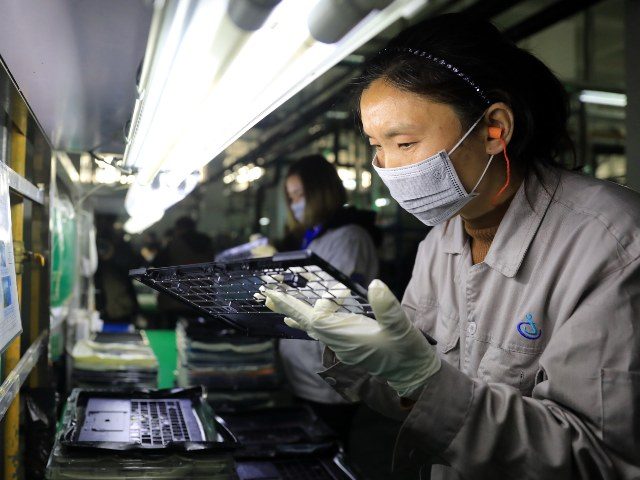The People’s Daily, the official newspaper of the Communist Party of China, boasted on Thursday that over 98 percent of “industrial enterprises above designated size” had returned to manufacturing, despite the ongoing Chinese coronavirus outbreak in the country.
Dictator Xi Jinping has repeatedly claimed that the Chinese outbreak, which has now become a pandemic, ended in mid-March, despite ample evidence of ongoing contagious within the authoritarian country. The World Health Organization (WHO) declared the outbreak a pandemic the day after Xi announced, in Wuhan, that China’s grief had ended.
Estimates based on the number of urns, each carrying one set of human remains, distributed out of Wuhan’s seven cemeteries this weekend suggest that between 30,000 and 40,000 people died this year since the lockdown began in January. China claims a little over 3,000 deaths due to Wuhan coronavirus nationwide.
The People’s Daily announcement of a Chinese economic miracle followed reports that the Communist Party is flooding empty factories with slaves relocated from Xinjiang’s concentration camps, housing between 1 million and 3 million ethnic minority Muslims, mostly Uyghurs, at their peak. Reports citing factory managers also indicate that manufacturing medical supplies, which many customer countries have complained are faulty and, thus, useless, is proving extremely profitable for Beijing.
“An average of 98.6 percent of industrial enterprises above designated size and 76 percent of the small and medium-sized enterprises (SMEs) across China have resumed work by March 28,” the People’s Daily reported on Thursday, citing a Chinese Communist Party official. “At present, China’s industrial fundamentals have become stable, and the basic trend of steady long-term growth for China’s economy remains unchanged.”
The government asserted that, among those industries seeing over 90 percent of their employee capacity return are electronics, iron and steel but that, even including car manufacturing and textiles, factories have over 70 percent of the employees they need.
The use of the word “returned” implies that the employees forced to leave their posts either by quarantines or illnesses are the same ones taking up those jobs. Due to estimates of the true death toll in China as a result of the pandemic and videos of hundreds of Uyghur Muslims being forcibly moved into factories nationwide, however, it is likely that the people working these factories now are not the ones there before the outbreak.
The number of factories returning to work, if true, adds to the evidence offered by the Communist Party’s Global Times propaganda newspaper last week that China is keeping its industrial “engine roaring.” The Times claimed that significant demand for medical supplies and personal protective gear, particularly from Europe, was still higher than the amount of the goods China currently had available to sell, but that its factories were working to “ensure global medical supplies amid the pandemic.”
Manufacturing medical or sanitary masks appears to be one of the most profitable enterprises, according to a report published last week by Hong Kong’s RTHK broadcast.
“The profit of a mask now is at least several cents compared to less than one in the past. Printing 60,000 or 70,000 masks a day is equivalent to printing money,” Shi Xinghui, the manager of an N95 mask manufacturer in southern Guangdong province, told the outlet.
Another factory owner, Qi Guangtu, estimated that a mask manufacturing machine could pay for itself in about a fortnight.
These profits may be even higher if the factories are using slave labor. Multiple human rights outlets, including Bitter Winter and Radio Free Asia (RFA), have published videos showing hundreds of Uyghurs transported far from their native Xinjiang province to work in factories. Bitter Winter speculated that the videos appeared on Chinese social media outlets like TikTok because the government hoped to use them as propaganda, praising the Uyghurs for “willingly” choosing to work the factories.
The Australian Strategic Policy Institute (ASPI), a think-tank based on the continent, published a report in March titled “Uyghurs for Sale” that revealed China “facilitated the mass transfer of Uyghur and other ethnic minority citizens from the far west region of Xinjiang to factories across the country.” China incentivized its manufacturers to take in Uyghur slaves through government programs that offered financial benefits if taking in the Uyghurs. The advertising selling Uyghur slaves began appearing on Chinese websites, encouraged by the government, shortly after Beijing declared that its victims in the Xinjiang concentration camps, which it claimed were “vocational training centers,” had “graduated” from their “training.”
Survivors of the camps have testified that the “training” they experienced included systematic rape, torture, slavery, communist indoctrination, forced sterilization, forced abortions, and being forced to watch acts of murder and rape. Some said they were subject to medical tests typically used in analyzing organ donors, suggesting that the Communist Party is harvesting organs from its political prisoners and selling them on the black market.
Chinese state media have boasted of doctors using lung transplants to treat coronavirus patients, alarming human rights activists who have compiled evidence of live organ harvesting from political prisoners.

COMMENTS
Please let us know if you're having issues with commenting.